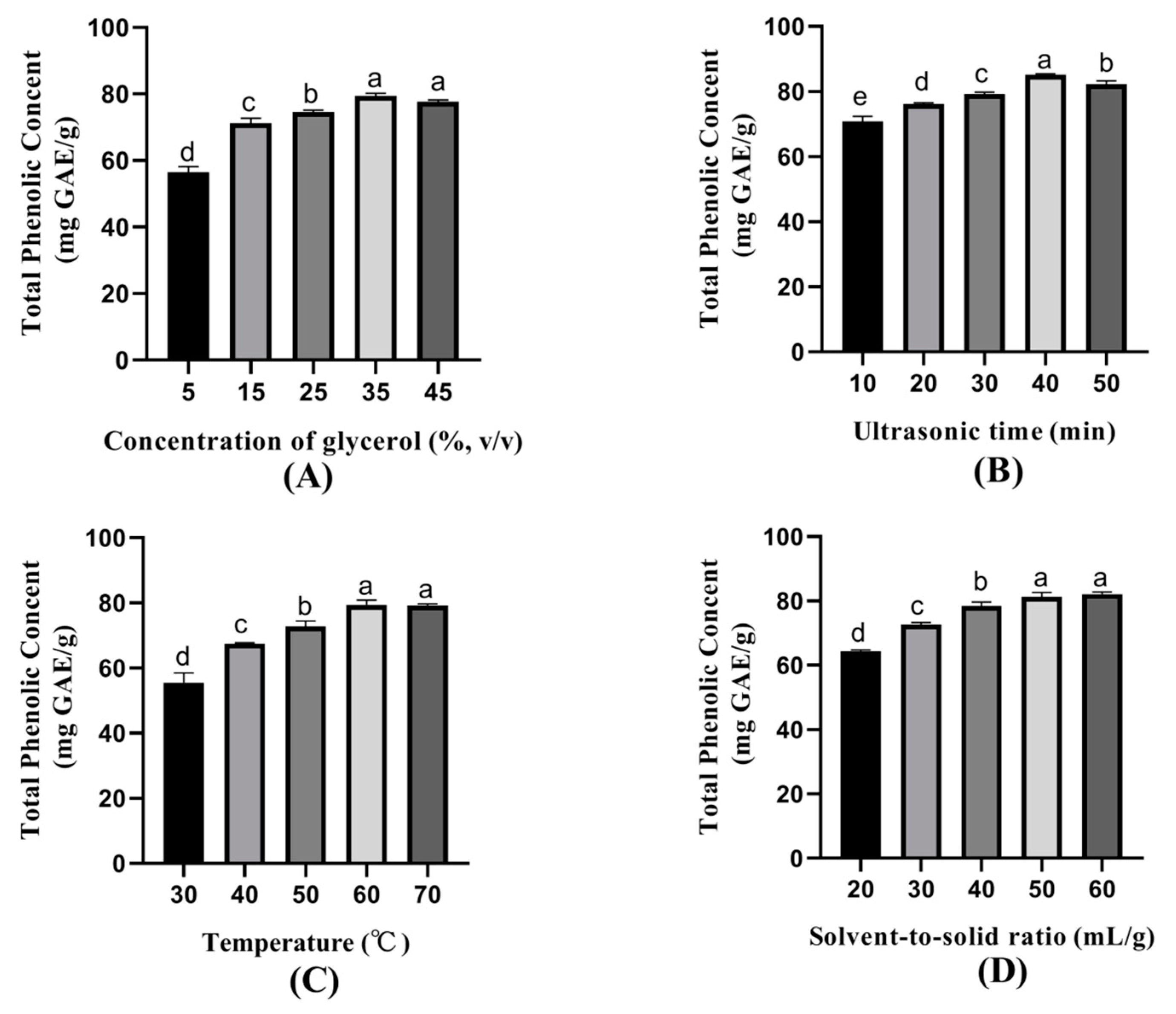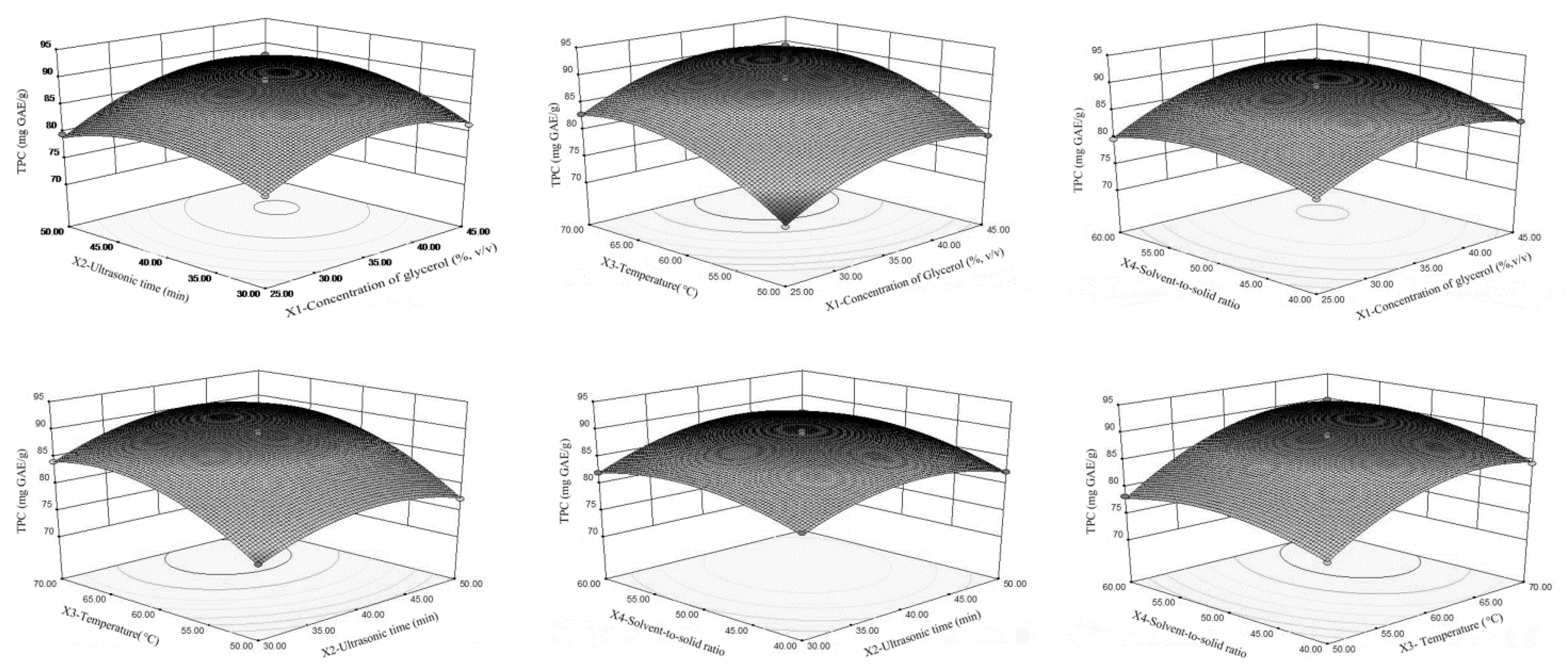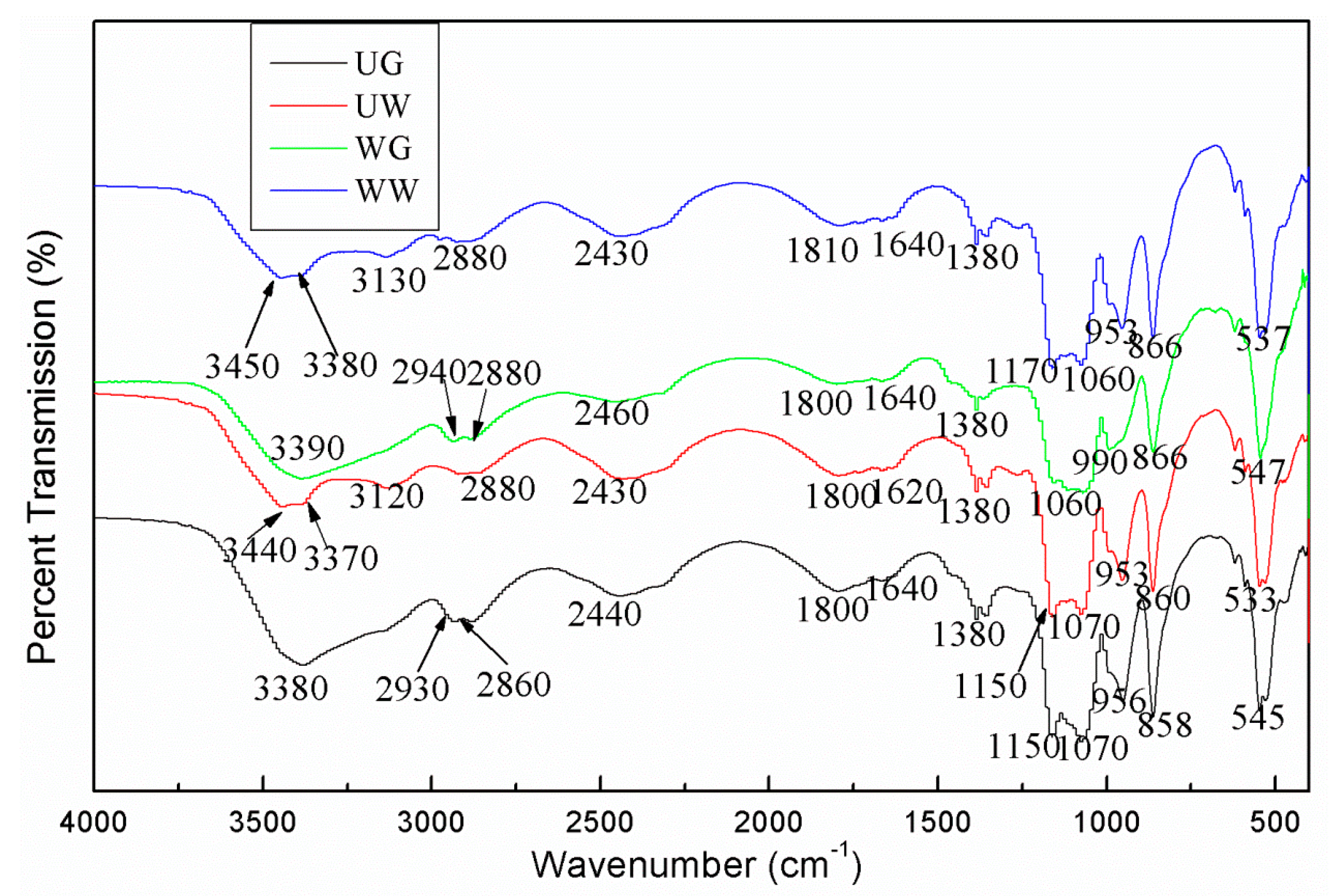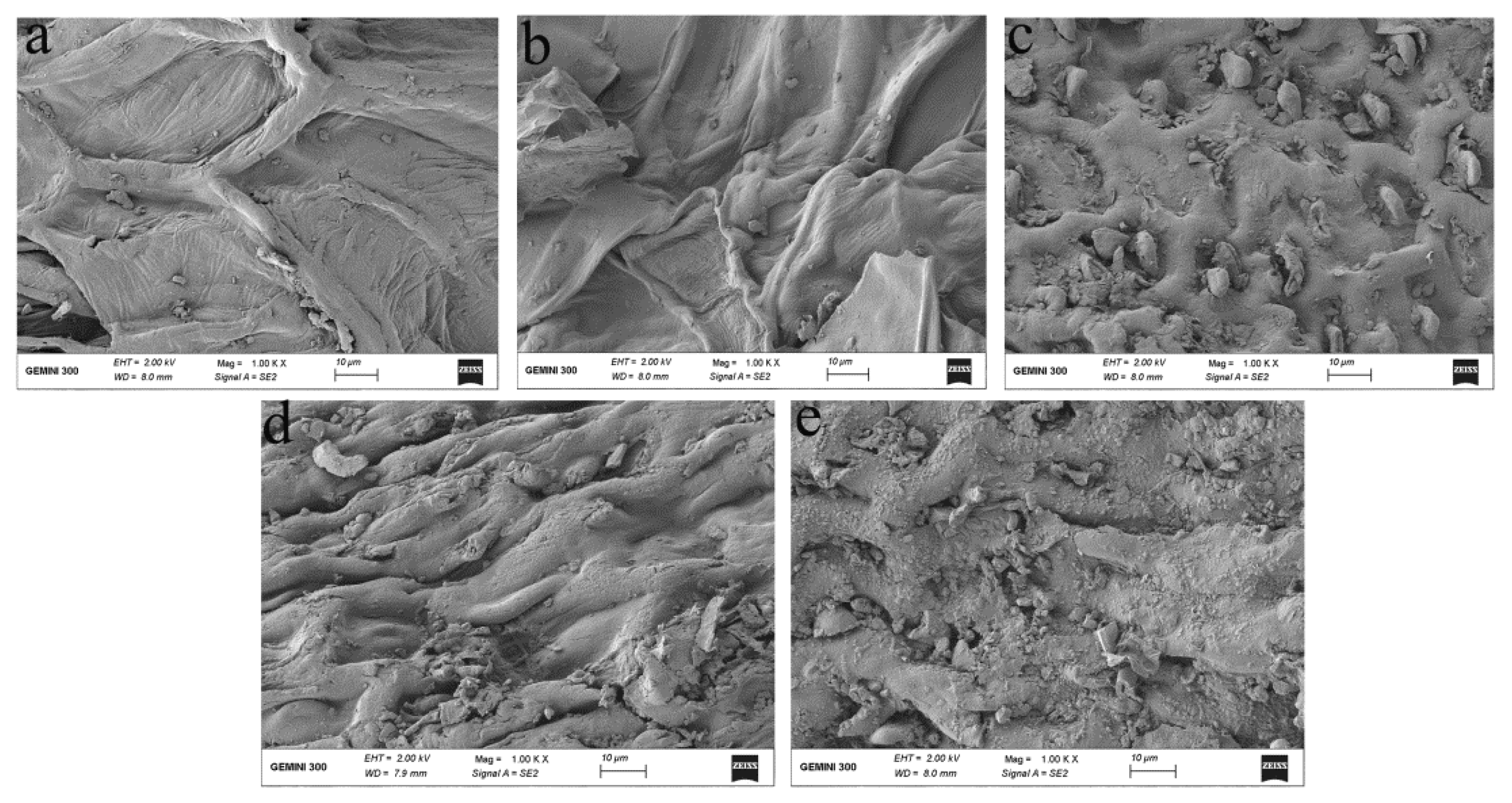Green Extraction of Phenolic Compounds from Lotus Seedpod (Receptaculum Nelumbinis) Assisted by Ultrasound Coupled with Glycerol
Abstract
1. Introduction
2. Materials and Methods
2.1. Plant Material and Reagents
2.2. Sample Preparation
2.3. RSM Design
2.4. Phenolic Compounds Analysis
2.5. Antioxidant Activities
2.6. Identification of Constituents by UPLC-Triple-TOF/MS
2.7. FTIR Spectrometry Analysis
2.8. Scanning Electron Microscope (SEM)
2.9. Statistical Analysis
3. Results and Discussion
3.1. Single Factor Analysis
3.2. Fitting the Model
+ 0.80X1X4 + 0.43X2X3 + 0.64X2X4 + 0.76X3X4 − 4.09X12 − 3.61X22 − 4.36X32 − 2.83X42
3.3. Validation of the Optimum Conditions
3.4. Extraction Yield of TFC, TCTC, and TTC
3.5. Antioxidant Activities
3.6. Identification of Constituents by UPLC-Triple-TOF/MS
3.7. FTIR Analysis
3.8. SEM
4. Conclusions
Supplementary Materials
Author Contributions
Funding
Data Availability Statement
Conflicts of Interest
References
- Lee, S.; Shin, H. Effect of lotus seed and seedpod extracts on oxidative stability against lard during storage. J. Korean Soc. Appl. Biol. 2015, 58, 53–60. [Google Scholar] [CrossRef]
- Shen, Y.B.; Guan, Y.F.; Song, X.; He, J.L.; Xie, Z.X.; Zhang, Y.W.; Zhang, H.; Tang, D. Polyphenols extract from lotus seedpod (Nelumbo nucifera Gaertn): Phenolic compositions, antioxidant, and antiproliferative activities. Food Sci. Nutr. 2019, 7, 3062–3070. [Google Scholar] [CrossRef] [PubMed]
- Tian, W.Y.; Zhi, H.; Yang, C.; Wang, L.K.; Long, J.T.; Xiao, L.M.; Liang, J.Z.; Huang, Y.; Zheng, X.; Zhao, S.Q.; et al. Chemical composition of alkaloids of Plumula nelumbinis and their antioxidant activity from different habitats in China. Ind. Crop. Prod. 2018, 125, 537–548. [Google Scholar] [CrossRef]
- Zhang, L.J.; Cheng, Z.; Zhao, Q.; Wang, M.S. Green and efficient PEG-based ultrasound-assisted extraction of polysaccharides from superfine ground lotus plumule to investigate their antioxidant activities. Ind. Crop. Prod. 2017, 109, 320–326. [Google Scholar] [CrossRef]
- Ling, Z.Q.; Xie, B.J.; Yang, E.L. Isolation, characterization, and determination of antioxidative activity of oligomeric procyanidins from the seedpod of Nelumbo nucifera Gaertn. J. Agr. Food Chem. 2005, 53, 2441–2445. [Google Scholar] [CrossRef]
- Yan, Z.; Zhang, H.H.; Dzah, C.S.; Zhang, J.X.; Diao, C.R.; Ma, H.L.; Duan, Y. Subcritical water extraction, identification, antioxidant and antiproliferative activity of polyphenols from lotus seedpod. Sep. Purif. Technol. 2020, 236, 116–217. [Google Scholar] [CrossRef]
- Hilbig, J.; Alves, V.R.; Muller, C.M.; Micke, G.A.; Vitali, L.; Pedrosa, R.C.; Block, J.M. Ultrasonic-assisted extraction combined with sample preparation and analysis using LC-ESI-MS/MS allowed the identification of 24 new phenolic compounds in pecan nut shell [Carya illinoinensis (Wangenh) C. Koch] extracts. Food Res. Int. 2018, 106, 549–557. [Google Scholar] [CrossRef]
- Goltz, C.; Avila, S.; Barbieri, J.B.; Igarashimafra, L.; Mafra, M.R. Ultrasound-assisted extraction of phenolic compounds from Macela (Achyrolcine satureioides) extracts. Ind. Crop. Prod. 2018, 115, 227–234. [Google Scholar] [CrossRef]
- Das, A.B.; Goud, V.V.; Das, C. Extraction of phenolic compounds and anthocyanin from black and purple rice bran (Oryza sativa L.) using ultrasound: A comparative analysis and phytochemical profiling. Ind. Crop. Prod. 2017, 95, 332–341. [Google Scholar] [CrossRef]
- Skalicka-Woz’niak, K.; Szypowski, J.; Glowniak, K. HPLC analysis of kaempferol and quercetin derivatives isolated by different extraction techniques from plant matrix. J. AOAC Int. 2011, 94, 17–21. [Google Scholar] [CrossRef]
- Corbin, C.; Fidel, T.; Leclerc, E.A.; Barakzoy, E.; Sagot, N.; Falguieres, A.; Renouard, S.; Blondeau, J.; Ferroud, C.; Doussot, J.; et al. Development and validation of an efficient ultrasound assisted extraction of phenolic compounds from flax (Linum usitatissimum L.) seeds. Ultrason. Sonochem. 2015, 26, 176–185. [Google Scholar] [CrossRef] [PubMed]
- Goldsmith, C.D.; Vuong, Q.V.; Stathopoulos, C.E.; Roach, P.D.; Scarlett, C.J. Ultrasound increases the aqueous extraction of phenolic compounds with high antioxidant activity from olive pomace. LWT—Food Sci. Technol. 2018, 89, 284–290. [Google Scholar] [CrossRef]
- Zhou, P.F.; Wang, X.P.; Liu, P.Z.; Huang, J.; Wang, C.; Pan, M.S.; Kuang, Z. Enhanced phenolic compounds extraction from Morus alba L. leaves by deep eutectic solvents combined with ultrasonic-assisted extraction. Ind. Crop. Prod. 2018, 120, 147–154. [Google Scholar] [CrossRef]
- Huang, H.; Belwal, T.; Jiang, L.; Hu, J.W.; Limwachiranon, J.; Li, L.; Ren, G.P.; Zhang, X.B.; Luo, Z.S. Valorization of lotus byproduct (Receptaculum Nelumbinis) under green extraction condition. Food Bioprod. Process. 2019, 115, 110–117. [Google Scholar] [CrossRef]
- Huang, H.; Xu, Q.; Belwal, T.; Li, L.; Aalim, H.; Wu, Q.; Duan, Z.H.; Zhang, X.B.; Luo, Z.S. Ultrasonic impact on viscosity and extraction efficiency of polyethylene glycol: A greener approach for anthocyanins recovery from purple sweet potato. Food Chem. 2019, 283, 59–67. [Google Scholar] [CrossRef]
- Limwachiranon, J.; Jiang, L.; Huang, H.; Sun, J.; Luo, Z.S. Improvement of phenolic compounds extraction from high-starch lotus (Nelumbo nucifera G.) seed kernels using glycerol: New insights to amylose/amylopectin—phenolic relationships. Food Chem. 2019, 274, 933–941. [Google Scholar] [CrossRef]
- Li, J.G.; Fan, S.T.; Qiu, Z.H.; Li, C.; Nie, S.P. Total flavonoids content; antioxidant and antimicrobial activities of extracts from Mosla chinensis Maxim. cv. Jiangxiangru. LWT—Food Sci. Technol. 2015, 64, 1022–1027. [Google Scholar] [CrossRef]
- Koutsoukos, S.; Tsiaka, T.; Tzani, A.; Zoumpoulakis, P.; Detsi, A. Choline chloride and tartaric acid, a natural deep eutectic solvent for the efficient extraction of phenolic and carotenoid compounds. J. Clean Prod. 2019, 241, 118–384. [Google Scholar] [CrossRef]
- Swain, T.; Hillis, W.E. The phenolic constituents of prunus domestica. I.-the quantitative analysis of phenolic constituents. J. Sci. Food Agr. 1959, 10, 63–68. [Google Scholar] [CrossRef]
- Brandwilliams, W.; Cuvelier, M.; Berset, C. Use of a free radical method to evaluate antioxidant activity. LWT—Food Sci. Technol. 1995, 28, 25–30. [Google Scholar] [CrossRef]
- Oldoni, T.L.C.; Merlin, N.; Karling, M.; Carpes, S.T.; De Alencar, S.M.; Morales, R.G.F.; Silva, E.; Pilau, E.J. Bioguided extraction of phenolic compounds and UHPLC-ESI-Q-TOF-MS/MS characterization of extracts of Moringa oleifera leaves collected in Brazil. Food Res. Int. 2019, 125, 1–9. [Google Scholar] [CrossRef] [PubMed]
- Marmouzi, I.; Kharbach, M.; Jemli, M.E.; Bouyahya, A.; Cherrah, Y.; Bouklouze, A.; Heyden, Y.V.; Faouzi, M.E. Antidiabetic, dermatoprotective, antioxidant and chemical functionalities in Zizyphus lotus leaves and fruits. Ind. Crop. Prod. 2019, 132, 134–139. [Google Scholar] [CrossRef]
- Oyaizu, M. Studies on products of browning reaction: Antioxidative activity of products of browning reaction. Jpn. J. Nutr. 1986, 44, 307–315. [Google Scholar] [CrossRef]
- Zeng, F.; Ge, Z.; Limwachiranon, J.; Li, L.; Feng, S.; Wang, Y.; Luo, Z. Antioxidant and tyrosinase inhibitory activity of Rosa roxburghii fruit and identification of main bioactive phytochemicals by UPLC-Triple-TOF/MS. Int. J. Food Sci. Technol. 2017, 52, 897–905. [Google Scholar] [CrossRef]
- Feng, S.; Luo, Z.; Tao, B.; Chen, C. Ultrasonic-assisted extraction and purification of phenolic compounds from sugarcane (Saccharum officinarum L.) rinds. LWT—Food Sci. Technol. 2015, 60, 970–976. [Google Scholar] [CrossRef]
- Shehata, E.; Grigorakis, S.; Loupassaki, S.; Makris, D.P. Extraction optimisation using water/glycerol for the efficient recovery of polyphenolic antioxidants from two Artemisia species. Sep. Purif. Technol. 2015, 149, 462–469. [Google Scholar] [CrossRef]
- Galanakis, C.M.; Goulas, V.; Tsakona, S.; Manganaris, G.A.; Gekas, V. A knowledge base for the recovery of natural phenols with different solvents. Int. J. Food Prop. 2013, 16, 382–396. [Google Scholar] [CrossRef]
- Naczk, M.; Shahidi, F. Phenolics in cereals, fruits and vegetables: Occurrence, extraction and analysis. J. Pharm. Biomed. Anal. 2006, 41, 1523–1542. [Google Scholar] [CrossRef]
- McClements, D.J. Advances in the application of ultrasound in food analysis and processing. Trends Food Sci. Technol. 1995, 6, 293–299. [Google Scholar] [CrossRef]
- Pai-Shih, C.; Duu-Jong, L.; Whiteley, C.G.; Chun-Yung, H. Antioxidant phenolic compounds from Pinus morrisconicola using compressional-puffing pretreatment and water–ethanol extraction: Optimization of extraction parameters. J. Taiwan Inst. Chem. E 2017, 70, 7–14. [Google Scholar]
- Khemakhem, I.; Ahmadqasem, M.H.; Catalan, E.B.; Micol, V.; Garciaperez, J.V.; Ayadi, M.A.; Bouaziz, M. Kinetic improvement of olive leaves’ bioactive compounds extraction by using power ultrasound in a wide temperature range. Ultrason. Sonochem. 2017, 34, 466–473. [Google Scholar] [CrossRef] [PubMed]
- Tao, Y.; Zhang, Z.; Sun, D. Kinetic modeling of ultrasound-assisted extraction of phenolic compounds from grape marc: Influence of acoustic energy density and temperature. Ultrason. Sonochem. 2014, 21, 1461–1469. [Google Scholar] [CrossRef] [PubMed]
- Chemat, F.; Zill-e-Huma; Khan, M.K. Applications of ultrasound in food technology: Processing, preservation and extraction. Ultrason. Sonochem. 2011, 18, 813–835. [Google Scholar] [CrossRef] [PubMed]
- Rashed, M.M.A.; Tong, Q.Y.; Abdelhai, M.H.; Gasmalla, M.M.A.; Ndayishimiye, J.B.; Chen, L.; Ren, F. Effect of ultrasonic treatment on total phenolic extraction from Lavandula pubescens and its application in palm olein oil industry. Ultrason. Sonochem. 2016, 29, 39–47. [Google Scholar] [CrossRef] [PubMed]
- Fu, X.Z.; Belwal, T.; Cravotto, G.; Luo, Z.S. Sono-physical and sono-chemical effects of ultrasound: Primary applications in extraction and freezing operations and influence on food components. Ultrason. Sonochem. 2020, 60, 104726. [Google Scholar] [CrossRef] [PubMed]
- Aalim, H.; Belwal, T.; Jiang, L.; Huang, H.; Meng, X.; Luo, Z. Extraction optimization, antidiabetic and antiglycation potentials of aqueous glycerol extract from rice (Oryza sativa L.) bran. LWT—Food Sci. Technol. 2019, 103, 147–154. [Google Scholar] [CrossRef]
- Kantar, S.E.; Rajha, H.N.; Boussetta, N.; Vorobiev, E.; Maroun, R.G.; Louka, N. Green extraction of polyphenols from grapefruit peels using high voltage electrical discharges, deep eutectic solvents and aqueous glycerol. Food Chem. 2019, 295, 165–171. [Google Scholar] [CrossRef]
- Medini, F.; Fellah, H.; Ksouri, R.; Abdelly, C. Total phenolic, flavonoid and tannin contents and antioxidant and antimicrobial activities of organic extracts of shoots of the plant Limonium delicatulum. J. Taibah Univ. Sci. 2014, 8, 216–224. [Google Scholar] [CrossRef]
- Luo, X.H.; Bai, R.L.; Zhen, D.S.; Yang, Z.B.; Huang, D.N.; Mao, H.L.; Li, X.F.; Zou, H.T.; Xiang, Y.; Liu, K.L.; et al. Response surface optimization of the enzyme-based ultrasound-assisted extraction of acorn tannins and their corrosion inhibition properties. Ind. Crop. Prod. 2019, 129, 405–413. [Google Scholar] [CrossRef]
- Saifullah, M.; McCullum, R.; McCluskey, A.; Vuong, Q. Comparison of conventional extraction technique with ultrasound assisted extraction on recovery of phenolic compounds from lemon scented tea tree (Leptospermum petersonii) leaves. Heliyon 2020, 6, e03666. [Google Scholar] [CrossRef]
- Apostolakis, A.; Grigorakis, S.; Makris, D.P. Optimisation and comparative kinetics study of polyphenol extraction from olive leaves (Olea europaea) using heated water/glycerol mixtures. Sep. Purif. Technol. 2014, 128, 89–95. [Google Scholar] [CrossRef]
- Alara, O.R.; Abdurahman, N.H.; Ukaegbu, C.I. Soxhlet extraction of phenolic compounds from Vernonia cinerea leaves and its antioxidant activity. J. Appl. Res. Med. Aroma Plants 2018, 11, 12–17. [Google Scholar] [CrossRef]
- Alara, O.R.; Abdurahman, N.H.; Ukaegbu, C.I.; Azhari, N.H. Vernonia cinerea leaves as the source of phenolic compounds, antioxidants, and anti-diabetic activity using microwave-assisted extraction technique. Ind. Crop. Prod. 2018, 122, 533–544. [Google Scholar] [CrossRef]
- Shahram, H.; Dinani, S.T. Influences of electrohydrodynamic time and voltage on extraction of phenolic compounds from orange pomace. LWT—Food Sci. Technol. 2019, 111, 23–30. [Google Scholar] [CrossRef]
- Sim, Y.Y.; Ong, W.T.; Nyam, K.L. Effect of various solvents on the pulsed ultrasonic assisted extraction of phenolic compounds from Hibiscus cannabinus L. leaves. Ind. Crop. Prod. 2019, 140, 111708. [Google Scholar] [CrossRef]
- Oliveira, R.N.; Mancini, M.C.; De Oliveira, F.C.; Passos, T.M.; Quilty, B.; Thire, R.M.; Mcguinness, G.B. FTIR analysis and quantification of phenols and flavonoids of five commercially available plants extracts used in wound healing. Materia 2016, 21, 767–779. [Google Scholar] [CrossRef]
- Rai, S.; Kureel, A.K.; Dutta, P.K.; Mehrotra, G.K. Phenolic compounds based conjugates from dextran aldehyde and BSA: Preparation, characterization and evaluation of their anti-cancer efficacy for therapeutic applications. Int. J. Biol. Macromol. 2018, 110, 425–436. [Google Scholar] [CrossRef]
- Nordin, N.; Othman, S.H.; Rashid, S.A.; Basha, R.K. Effects of glycerol and thymol on physical, mechanical, and thermal properties of corn starch films. Food Hydrocoll. 2020, 106, 105884. [Google Scholar] [CrossRef]
- Choi, I.Y.; Lee, S.E.; Chang, Y.; Lacroix, M.; Han, J. Effect of oxidized phenolic compounds on cross-linking and properties of biodegradable active packaging film composed of turmeric and gelatin. LWT—Food Sci. Technol. 2018, 93, 427–433. [Google Scholar] [CrossRef]





| Independent Variables | Levels | ||
|---|---|---|---|
| −1 | 0 | 1 | |
| X1: concentration of glycerol (%) | 25 | 35 | 45 |
| X2: ultrasonic time (min) | 30 | 40 | 50 |
| X3: temperature (°C) | 50 | 60 | 70 |
| X4: solvent-to-solid ratio (mL/g) | 40 | 50 | 60 |
| Run | X1: Concentration of Glycerol | X2: Ultrasonic Time (min) | X3: Temperature (°C) | X4: Solvent-to-Solid Ratio | Experimental Values | Predicted Values |
|---|---|---|---|---|---|---|
| 1 | 45.00 | 40.00 | 70.00 | 50.00 | 89.2097 | 88.85 |
| 2 | 35.00 | 30.00 | 60.00 | 60.00 | 82.0877 | 82.06 |
| 3 | 35.00 | 40.00 | 60.00 | 50.00 | 88.8395 | 89.19 |
| 4 | 45.00 | 40.00 | 60.00 | 40.00 | 82.9761 | 82.93 |
| 5 | 35.00 | 30.00 | 60.00 | 40.00 | 80.3109 | 79.98 |
| 6 | 45.00 | 40.00 | 50.00 | 50.00 | 78.9191 | 78.90 |
| 7 | 35.00 | 40.00 | 60.00 | 50.00 | 89.0616 | 89.19 |
| 8 | 25.00 | 40.00 | 50.00 | 50.00 | 72.1821 | 72.41 |
| 9 | 35.00 | 50.00 | 60.00 | 40.00 | 82.2654 | 82.17 |
| 10 | 35.00 | 50.00 | 60.00 | 60.00 | 86.6185 | 86.82 |
| 11 | 25.00 | 40.00 | 60.00 | 40.00 | 78.1788 | 78.26 |
| 12 | 45.00 | 50.00 | 60.00 | 50.00 | 87.729 | 87.52 |
| 13 | 45.00 | 30.00 | 60.00 | 50.00 | 81.2882 | 81.72 |
| 14 | 35.00 | 50.00 | 50.00 | 50.00 | 77.2164 | 77.45 |
| 15 | 35.00 | 50.00 | 70.00 | 50.00 | 88.0252 | 88.47 |
| 16 | 25.00 | 40.00 | 70.00 | 50.00 | 82.9169 | 82.81 |
| 17 | 25.00 | 30.00 | 60.00 | 50.00 | 77.7346 | 77.78 |
| 18 | 25.00 | 40.00 | 60.00 | 60.00 | 79.6891 | 80.02 |
| 19 | 35.00 | 30.00 | 70.00 | 50.00 | 84.1014 | 84.15 |
| 20 | 45.00 | 40.00 | 60.00 | 60.00 | 87.6846 | 87.89 |
| 21 | 35.00 | 40.00 | 60.00 | 50.00 | 89.0616 | 89.19 |
| 22 | 35.00 | 40.00 | 70.00 | 60.00 | 89.8168 | 89.53 |
| 23 | 35.00 | 40.00 | 50.00 | 40.00 | 75.869 | 76.00 |
| 24 | 35.00 | 40.00 | 70.00 | 40.00 | 84.3976 | 84.66 |
| 25 | 25.00 | 50.00 | 60.00 | 50.00 | 79.5114 | 78.93 |
| 26 | 35.00 | 30.00 | 50.00 | 50.00 | 74.9954 | 74.83 |
| 27 | 35.00 | 40.00 | 60.00 | 50.00 | 89.2837 | 89.19 |
| 28 | 35.00 | 40.00 | 60.00 | 50.00 | 89.7279 | 89.19 |
| 29 | 35.00 | 40.00 | 50.00 | 60.00 | 78.2676 | 77.85 |
| Source | Sum of Squares | df | Mean Square | F-Value | p-Value Prob > F |
|---|---|---|---|---|---|
| Model | 751.08 | 14 | 53.65 | 346.68 | <0.0001 |
| X1- concentration of glycerol | 117.77 | 1 | 117.77 | 761.08 | <0.0001 |
| X2- ultrasonic time | 36.22 | 1 | 36.22 | 234.05 | <0.0001 |
| X3- temperature | 310.27 | 1 | 310.27 | 2004.97 | <0.0001 |
| X4- solvent-to-solid ratio | 33.89 | 1 | 33.89 | 219.01 | <0.0001 |
| X1X2 | 5.44 | 1 | 5.44 | 35.14 | <0.0001 |
| X1X3 | 0.05 | 1 | 0.049 | 0.32 | 0.5813 |
| X1X4 | 2.56 | 1 | 2.56 | 16.52 | 0.0012 |
| X2X3 | 0.72 | 1 | 0.72 | 4.68 | 0.0482 |
| X2X4 | 1.66 | 1 | 1.66 | 10.72 | 0.0055 |
| X3X4 | 2.28 | 1 | 2.28 | 14.74 | 0.0018 |
| X12 | 108.75 | 1 | 108.75 | 702.77 | <0.0001 |
| X22 | 84.61 | 1 | 84.61 | 546.74 | <0.0001 |
| X32 | 123.16 | 1 | 123.16 | 795.89 | <0.0001 |
| X42 | 51.83 | 1 | 51.83 | 334.95 | <0.0001 |
| Residual | 2.17 | 14 | 0.15 | ||
| Lack of Fit | 1.71 | 10 | 0.17 | 1.51 | 0.3679 |
| Pure Error | 0.45 | 4 | 0.11 | ||
| Cor Total | 753.25 | 28 | |||
| C.V.% | 0.47 | ||||
| Adeq Precision | 60.502 | ||||
| R2 | 0.9971 | ||||
| Adj R2 | 0.9942 | ||||
| Pred R2 | 0.9860 |
| Sample | TFC | TCTC | TTC |
|---|---|---|---|
| (mg QE/g) | (mg CE/g) | (mg TAE/g) | |
| UG | 70.09 ± 3.35a | 70.73 ± 4.76a | 68.94 ± 1.44b |
| UW | 72.41 ± 3.83a | 40.19 ± 0.72c | 47.22 ± 0.57c |
| WG | 60.97 ± 2.75b | 65.05 ± 2.95b | 72.27 ± 1.70a |
| WW | 58.05 ± 7.01b | 40.23 ± 0.92c | 41.26 ± 0.89d |
Publisher’s Note: MDPI stays neutral with regard to jurisdictional claims in published maps and institutional affiliations. |
© 2021 by the authors. Licensee MDPI, Basel, Switzerland. This article is an open access article distributed under the terms and conditions of the Creative Commons Attribution (CC BY) license (http://creativecommons.org/licenses/by/4.0/).
Share and Cite
Bao, N.; Wang, D.; Fu, X.; Xie, H.; Gao, G.; Luo, Z. Green Extraction of Phenolic Compounds from Lotus Seedpod (Receptaculum Nelumbinis) Assisted by Ultrasound Coupled with Glycerol. Foods 2021, 10, 239. https://doi.org/10.3390/foods10020239
Bao N, Wang D, Fu X, Xie H, Gao G, Luo Z. Green Extraction of Phenolic Compounds from Lotus Seedpod (Receptaculum Nelumbinis) Assisted by Ultrasound Coupled with Glycerol. Foods. 2021; 10(2):239. https://doi.org/10.3390/foods10020239
Chicago/Turabian StyleBao, Nina, Di Wang, Xizhe Fu, Hujun Xie, Guizhen Gao, and Zisheng Luo. 2021. "Green Extraction of Phenolic Compounds from Lotus Seedpod (Receptaculum Nelumbinis) Assisted by Ultrasound Coupled with Glycerol" Foods 10, no. 2: 239. https://doi.org/10.3390/foods10020239
APA StyleBao, N., Wang, D., Fu, X., Xie, H., Gao, G., & Luo, Z. (2021). Green Extraction of Phenolic Compounds from Lotus Seedpod (Receptaculum Nelumbinis) Assisted by Ultrasound Coupled with Glycerol. Foods, 10(2), 239. https://doi.org/10.3390/foods10020239






